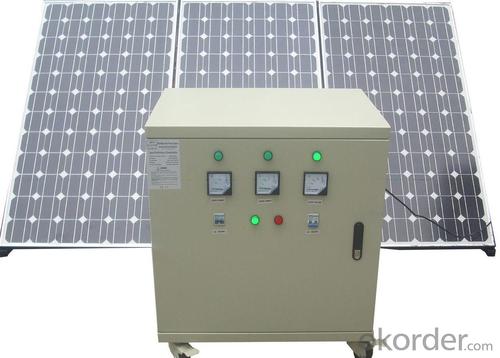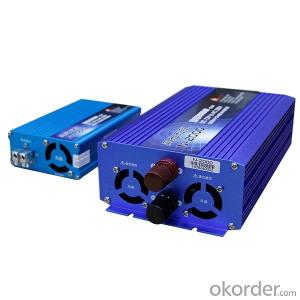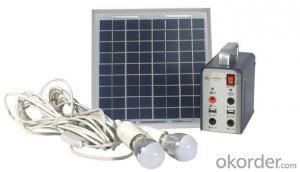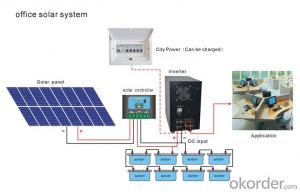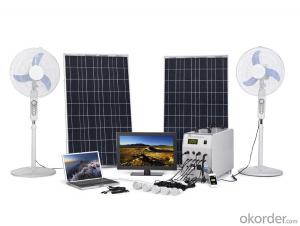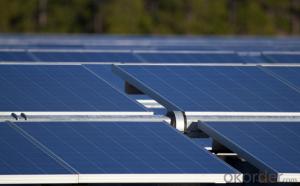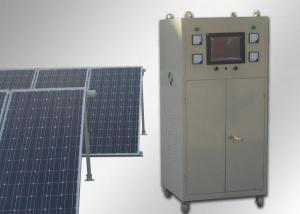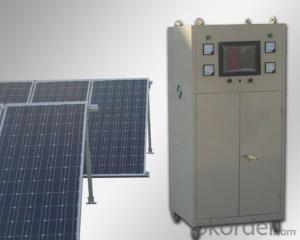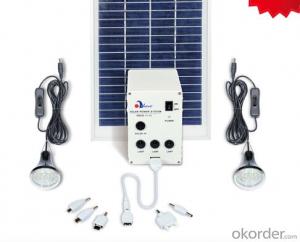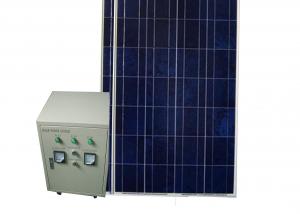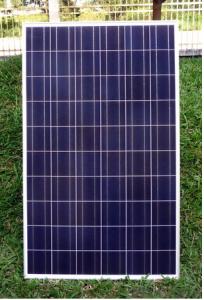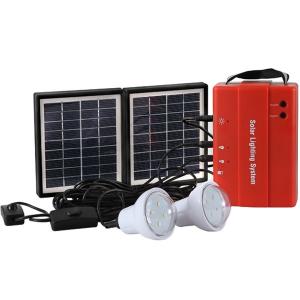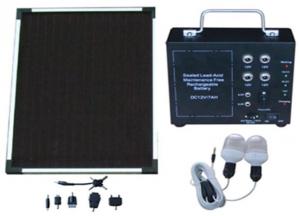Commercial Solar Energy Systems - CNBM Solar Home System CNBM-K5 (500W)
- Loading Port:
- China Main Port
- Payment Terms:
- TT
- Min Order Qty:
- 1 set set
- Supply Capability:
- 1000 sets per month set/month
OKorder Service Pledge
OKorder Financial Service
You Might Also Like
Brief Introduction of Solar Energy System CNBM-K5 (500W)
CNBM Home System-K5 (500W) has a wonderful capacity.It can be used in factory,home,school and other CNBM Home System-K5 (500W) consist of the solar modules,charge controller,inverter and battery banks.
CNBM International is highly recognized by its business partners and clients all over the world and has obtained rapid development under the spirit of win-win .
With CNBM Home System-K5 (500W),
We will carry on the mutual beneficial,innovative and revolutionary trading structure as we did before,create value for our employees,share holders and clients and benefit the whole society in our future development.Please contact us ,if you have interest in CNBM Home System-K5 (500W),don’t hesitate!
The Sketching of Solar Energy System CNBM-K5 (500W)
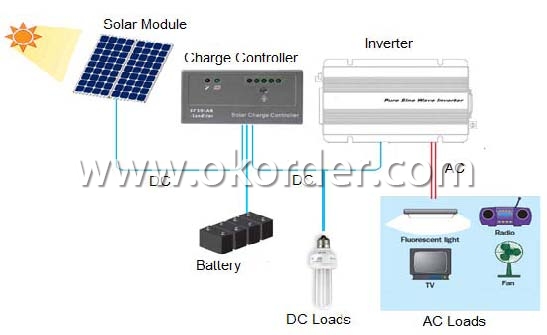
Components of Solar Energy System CNBM-K5 (500W)
PV Array:
Convert sunlight instantly into DC electric power. Formed by the solar modules (also called photovoltaic modules) in accordance with the system requirements for series and parallel.
Solar Charge Controller:
A charge controller may be used to power DC equipment with solar panels. The charge controller provides a regulated DC output and stores excess energy in a battery as well as monitoring the battery voltage to prevent over charge or over discharge. An inverter can be connected to the output of a charge controller to drive AC loads.
Inverter:
Converts DC output power of photovaltaic soalr panels into standard AC power for use in the local off-grid electrical network. It is a critical component in a photovoltaic system, allowing the use of ordinary commercial appliances.
Battery banks:
Stores energy when there is an excess coming in and distribute it back out when there is a demand. Solar PV panels continue to re-charge batteries each day to maintain battery charge.
Technical data of Solar Home System CNBM-K5 (500W) | ||
Inverter | Rated load power | 1000W |
Output wave | Pure sine wave | |
Output voltage | DC 24V | |
Output frequency |
AC:220V | |
Precision of output | 50HZ/60HZ | |
Precision of output frequency | ±6% | |
Solar panel | Pmax | 165W*3PCS |
Vmp | 36V | |
Imp | 4.63A*3 | |
Charger | Charger voltage & current | 24V /10A*3 |
Battery | Capacity | 12V 120AH*2PCS |
Power box | Spray paint iron box,with input,output,ammeter,voltmeter,master swith and so on. | |
Package of Solar Home System CNBM-K5 (500W) | ||||
Part | Size(L*W*H mm) | Weight(kg) | 20’(pcs) | 40’(pcs) |
Power box | 580*520*540 | 60 | 70 Sets | 160 Sets |
Solar panel | 1600*830*90 | 45 | ||
Battery | 420*360*240 | 80 | ||
Factory Picture of Solar Energy System CNBM-K5 (500W)
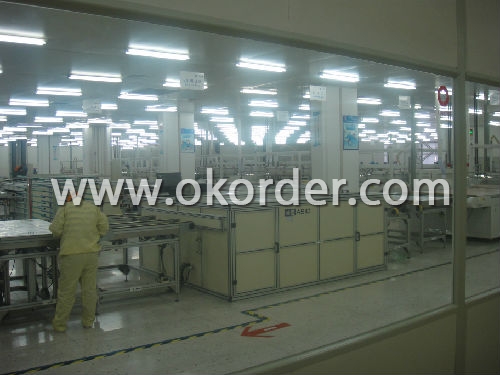
Package Picture of Solar Energy System CNBM-K5 (500W)

- Q: Can solar energy systems be installed on multi-story buildings?
- Yes, solar energy systems can be installed on multi-story buildings. The installation process may require careful planning and considerations due to the building's height, available space, and structural integrity. However, with appropriate design and engineering, solar panels can be mounted on rooftops, facades, or even as elevated structures to harness solar energy efficiently on multi-story buildings.
- Q: Can solar energy systems be used in powering research laboratories or scientific facilities?
- Certainly, research laboratories and scientific facilities can utilize solar energy systems to provide power. Solar energy is a sustainable and renewable power source that can be harnessed through the utilization of photovoltaic (PV) panels or solar thermal systems. To power various equipment such as microscopes, spectrometers, centrifuges, and other specialized scientific instruments, research laboratories and scientific facilities often require a substantial amount of electricity. By installing solar panels on the roofs or surrounding areas of these facilities, they can generate electricity from sunlight. The electricity generated by solar panels can directly power the laboratory's equipment, reducing their dependence on traditional fossil fuel-based electricity sources. Furthermore, any excess energy produced by the solar panels can be stored in batteries or returned to the grid, ensuring a continuous and reliable power supply. Using solar energy in research laboratories and scientific facilities offers several advantages. Firstly, it helps diminish greenhouse gas emissions and mitigates the environmental impact of these facilities. Solar power is clean and does not generate harmful pollutants, making it an environmentally friendly substitute for conventional electricity sources. Additionally, solar energy systems can provide a stable and cost-effective power source in the long term. While the initial installation costs may be higher, solar panels have a lengthy lifespan and require minimal upkeep. This can result in significant savings on electricity bills over time, enabling research laboratories and scientific facilities to allocate their resources towards other essential research activities. Moreover, solar energy systems can enhance the resilience and reliability of power supply to these facilities. In regions prone to power outages or with unreliable electricity grids, solar panels combined with battery storage can serve as a backup power source, guaranteeing uninterrupted operation of critical scientific equipment. In conclusion, solar energy systems can indeed be utilized to power research laboratories and scientific facilities. They offer numerous environmental, economic, and operational advantages, making them a feasible and sustainable choice for meeting the energy requirements of these vital scientific institutions.
- Q: Can solar energy systems be used for powering amusement parks or entertainment venues?
- Yes, solar energy systems can be used for powering amusement parks or entertainment venues. Solar power has emerged as a viable and sustainable alternative to traditional energy sources, providing numerous benefits for large-scale operations like amusement parks. Amusement parks and entertainment venues consume a significant amount of energy, especially during peak operating hours. By installing solar panels, these venues can generate clean and renewable energy on-site, reducing their dependence on fossil fuels and lowering their carbon footprint. This not only helps in combating climate change but also promotes environmental stewardship and sustainability. Solar energy systems can be designed to meet the specific energy needs of amusement parks. The expansive roofs of buildings, parking lots, and other open spaces can be utilized to install solar panels, maximizing the energy generation potential. Additionally, advancements in solar technology such as thin-film solar panels and solar canopies offer innovative solutions to integrate solar power seamlessly into the park's infrastructure. One of the key advantages of solar power is its ability to generate electricity during peak demand periods, which often align with the peak operating hours of amusement parks. This ensures a reliable and consistent power supply, preventing disruptions and ensuring a smooth and enjoyable experience for visitors. Furthermore, solar energy systems can also be coupled with battery storage solutions. Excess energy generated during the daytime can be stored in batteries and utilized during the evening or on cloudy days, ensuring uninterrupted power supply even when the sun is not shining. This enhances the reliability and resilience of the park's energy infrastructure. In addition to the environmental and operational benefits, solar energy systems can also provide cost savings in the long run. While the initial investment may be higher, the ongoing operational costs are significantly lower compared to traditional energy sources. The savings generated from reduced electricity bills can be reinvested into improving park infrastructure, enhancing visitor experiences, and expanding attractions. Amusement parks and entertainment venues have a unique opportunity to showcase their commitment to sustainability and renewable energy by adopting solar power systems. By harnessing the power of the sun, these venues can not only reduce their environmental impact but also inspire visitors to make more sustainable choices in their own lives. In conclusion, solar energy systems can indeed be utilized to power amusement parks and entertainment venues. The numerous benefits, including environmental sustainability, reliable power supply, cost savings, and the opportunity to promote renewable energy, make solar power an excellent choice for powering these large-scale operations.
- Q: What are the advantages of using solar energy systems?
- There are several advantages of using solar energy systems. Firstly, solar energy is a renewable and abundant source of power, meaning it will never run out and can be harnessed anywhere in the world. Additionally, using solar energy helps to reduce greenhouse gas emissions and combat climate change, as it produces no harmful pollutants during operation. Solar energy systems also provide energy independence, allowing individuals and communities to generate their own power and reduce reliance on traditional energy sources. Furthermore, solar energy can lead to cost savings in the long run, as it reduces electricity bills and offers potential financial incentives such as tax credits or feed-in tariffs. Lastly, solar energy systems require minimal maintenance and have a long lifespan, making them a reliable and durable option for generating clean energy.
- Q: Can solar energy systems be used for powering electric gates?
- Yes, solar energy systems can be used to power electric gates. Solar panels can generate electricity from sunlight, which can be stored in batteries and used to power electric gates. This allows for a sustainable and environmentally friendly solution for gate automation.
- Q: Can a solar energy system be installed in areas with extreme weather conditions?
- Yes, a solar energy system can be installed in areas with extreme weather conditions. However, the system should be designed and installed with the specific climate in mind to ensure durability and optimal performance. Components like solar panels, inverters, and mounting structures can be chosen to withstand extreme temperatures, high winds, heavy snowfall, or other challenging weather conditions. Additionally, regular maintenance and monitoring can help identify and address any weather-related issues that may arise, ensuring the longevity and efficiency of the solar energy system.
- Q: Can solar energy systems be used for powering refrigeration systems?
- Solar energy systems have the capability to power refrigeration systems. Through the use of solar panels, solar energy can be converted into electricity, which can then be utilized to operate refrigeration systems. This is commonly achieved by employing photovoltaic (PV) systems, which convert sunlight into electricity using semiconducting materials. The electricity generated by these systems can be employed to power the compressors and other components of refrigeration systems, enabling them to function independently from traditional power sources. By harnessing solar energy for refrigeration, not only can energy costs be reduced, but also the environmental impact can be minimized, as solar energy is a clean and renewable power source.
- Q: Can solar energy systems be used for powering off-grid educational institutions?
- Yes, solar energy systems can indeed be used for powering off-grid educational institutions. Solar panels can be installed on the rooftops of buildings to harness the sun's energy and convert it into electricity. This renewable energy source can then be used to power various electrical appliances, lighting, and other necessities within the educational institution. By utilizing solar power, off-grid educational institutions can reduce their dependence on traditional energy sources and contribute to a more sustainable and environmentally friendly way of generating electricity.
- Q: How much does it cost to install a solar energy system?
- The cost of installing a solar energy system can vary depending on various factors such as the size of the system, location, equipment used, and installation costs. On average, residential solar energy systems can range from $15,000 to $25,000 after accounting for tax incentives and rebates. However, it is recommended to obtain personalized quotes from solar installation companies to get an accurate estimate for your specific needs.
- Q: How does solar energy storage work?
- Solar energy storage is a crucial component of harnessing the power of the sun and using it to meet our energy needs even when the sun isn't shining. The process of solar energy storage involves capturing and storing the excess energy generated by solar panels during peak sunlight hours so that it can be used later when the demand for electricity is high or during nighttime hours. There are several methods of solar energy storage, but one of the most common and widely used is through the use of batteries. These batteries, typically made of lithium-ion or lead-acid, are used to store the excess electricity generated by the solar panels. During the day, when the sun is shining and the solar panels are producing electricity, any excess energy that is not immediately consumed by the household or building is directed to charge the batteries. Once the batteries are fully charged, the excess energy is stored and can be used at a later time when the solar panels are not producing electricity, such as during the night or on cloudy days. This stored energy can then be released back into the electrical system, providing power to the building or home. Another method of solar energy storage is through the use of thermal energy storage systems. These systems capture solar energy in the form of heat and store it in materials such as water, molten salt, or phase-change materials. The stored heat can then be used to generate electricity or provide heating and cooling to buildings. The stored solar energy can also be used to power other devices or appliances directly, without going through the electrical grid. This is particularly useful in remote areas or during power outages, where having a reliable and independent source of energy is essential. Overall, solar energy storage plays a crucial role in maximizing the efficiency and reliability of solar power systems. It allows us to store the excess energy generated during peak sunlight hours and use it when needed, reducing our reliance on traditional fossil fuel-based energy sources and contributing to a more sustainable and environmentally friendly energy future.
Send your message to us
Commercial Solar Energy Systems - CNBM Solar Home System CNBM-K5 (500W)
- Loading Port:
- China Main Port
- Payment Terms:
- TT
- Min Order Qty:
- 1 set set
- Supply Capability:
- 1000 sets per month set/month
OKorder Service Pledge
OKorder Financial Service
Similar products
Hot products
Hot Searches
Related keywords



